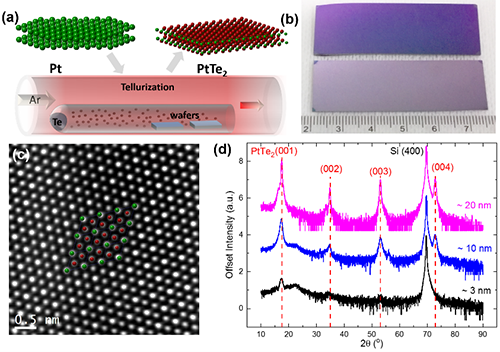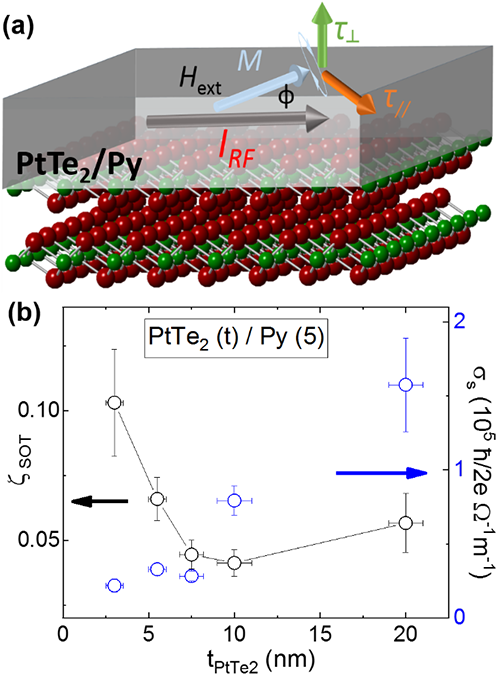High spin Hall conductivity in large-area type-II Dirac semimetal PtTe2
Date:14-04-2020 Print
Manipulation of magnetization by electric-current-induced spin-orbit torque (SOT) is of great importance for next generation of magnetic memory and logic because of its merits in energy-efficient and high-speed operation. Implement of SOT in spintronics devices made of metallic multilayers requires both large spin Hall angle and high conductivity (i.e. high spin Hall conductivity) in a material. Compared with the conventional heavy metal like Pt, W etc., two-dimensional transition metal dichalcogenides (TMDs) are appealing because of their tunability in phase, symmetry, conductivity, spin-orbit coupling and non-trivial energy band topology. It has been emerged as a new platform for studying the interplay between different degrees of freedom like charge and spin (or pseudospin). Although numerous reports revealed the relatively large spin Hall angle in TMDs including MoS2 and WTe2 etc., there are two crucial issues that need to be solved before application: the relatively low conductivity and the difficulty in controllably fabricating thin films in a large scale. Using high conductive Dirac semimetal with spin-momentum locking in its topological surface states might be a solution, however, studying of SOT in such system is still missing.

Figure 1. Synthesis of large-area high quality PtTe2 thin films and structure characterization. (a) Schematic illusion thermal-assisted transformation from Pt into PtTe2 thin films. (b) and (c) are optical microscopy image and HRTEM image of typical PtTe2 thin films in the centimeter and nanometer scales respectively. (d) XRD result of [001]- oriented PtTe2 thin films
Recently, Dr. Hongjun Xu, Prof. Guoqaing Yu and Prof. Xiufeng Han from the M02 group at the Institute of Physics, Chinese Academy of Sciences, has successfully fabricated large-area, high quality PtTe2 thin films with controllable thicknesses and study the SOT in this type-II Dirac semimetal material for the first time. Learning from the case of PtSe2, uniform and homogenous [001]-oriented PtTe2 thin films are transformed from Pt thin films by annealing them in tellurium vapor. Similar to the results of single-crystal PtTe2 nano flakes, the PtTe2 thin films are highly conductive at room temperature (~ 106 S/m). Because of their stability in ambient condition, the as-grown PtTe2 thin films can be transferred into another sputtering system for making spintronics stacks. After a systematic studying of SOT in the PtTe2/Py stacks with the ST-FMR method, large SOT efficiency was found: for the case of 5 nm PtTe2 the corresponding spin Hall angle is around 0.09-0.15 which is 1.5-2 times large than the value in the control sample of 4 nm Pt. A nonmonotonic behavior in the thickness dependence of SOT efficiency implies that the SOT in PtTe2 might originate from two different sources including bulk and surface contributions. A large spin Hall conductivity (0.2-1.6 × 105 ℏ/2e Ω-1m-1) is established in PtTe2 which is the largest one among TMDs reported so far and even comparable to the values of Bi2Se3, a representative topological insulator. Further work in perpendicular magnetic moment switching confirmed the higher efficiency of charge-spin conversion in PtTe2 than Pt. It suggests that PtTe2 and Dirac semimetal is compelling for low-power SOT devices and other applications related to charge-spin interconversion. This work paves the way for employing PtTe2-like TMDs for wafer-scale spintronic device applications [H. J. Xu, J. W. Wei, H. G. Zhou, J. F. Feng, T. Xu, H. F. Du, C. L. He, Y. Huang, J. W. Zhang, Y. Z. Liu, H.-C. Wu, C. Y. Guo, X. Wang, Y. Guang, H. X. Wei, Y. Peng, W. J. Jiang, G. Q. Yu,* and X. F. Han, High Spin Hall Conductivity in Large-Area Type-II Dirac Semimetal PtTe2, Adv. Mater. 10 (2020) 2000513]。.

Figure 2. Illustration of ST-FMR device and the result from them. (a) RF current (Irf) flowing in PtTe2 generates a SOT including in-plane (τ//) and out-of-plane (τ⊥) components and drives magnetization of Py into procession around the effective field direction. (b) Thickness dependence of SOT efficiency (ξSOT) and spin Hall conductivity (σs).
The work was supported by the Ministry of Science and Technology of China [No. 2017YFA0206200], the National Science Foundation [NSFC Nos. 11874409, 11674373, 51801087, 11804380], and the Chinese Academy of Sciences [QYZDJ-SSW-SLH016].
Article link:https://onlinelibrary.wiley.com/doi/full/10.1002/adma.202000513?af=R

